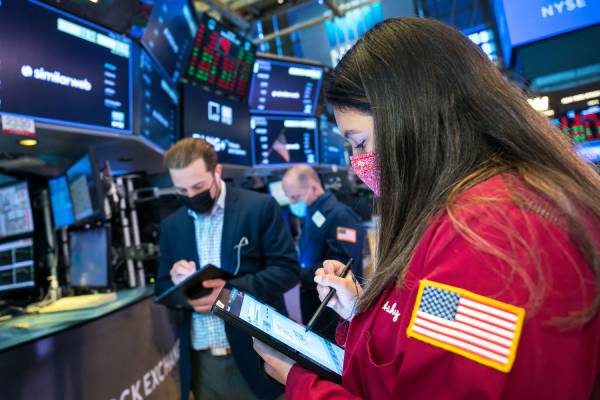
Indeed, even the most brilliant Wall Street financial backers couldn’t say whether markets will be up or down tomorrow, however they truly do appear to settle on a certain something: The approaching year will be a wild and hazardous ride.
With shopper costs ascending at their quickest level since the mid 1980s, the Fed is relied upon to climb loan fees soon, which will assist with containing expansion yet could make markets plunge. Dealers stress that out of this world market costs could crash as the national bank eases back its upgrade measures. All things considered, when the Fed fixed in 2018, costs fell strongly for stocks and items, and the Fed in the end turned around course.
The thrill ride is now in progress. Throughout one day, January 24, the Dow Jones Industrial Average plunged 1,000 focuses in early exchanging just to whipsaw and recapture all its worth by the market close. Maybe there was a securities exchange crash toward the beginning of the day, however at that point everybody altered their perspectives over mid-day break. What’s more even all through the remainder of the month, markets swung constantly. What on earth could cause such wild instability?
This is constraining the Fed’s hand. The main demonstrated method for battling expansion is to climb financing costs and fix the cash supply. This was the main thing that halted the Great Inflation during the 1970s.
Maybe therefore, Wall Street appears to question the Fed’s purpose to fix now. Toward the beginning of January, for instance, The Wall Street Journal announced that Fed authorities accepted that loan costs would ultimately hit 2.5%, yet market costs for specific securities showed that brokers accepted the Fed would just climb to 1.5%. This mirrors the back-and-forth that is in progress: Some brokers imagine that the Fed will fundamentally fix its money related strategy, yet others appear to accept that the Fed won’t let market costs fall. This ever changing has been continuing for quite a long time, yet what makes it different this time is expansion. In the event that the Fed doesn’t act, expansion could turn out to be much more serious and could undermine the whole monetary framework.
The elements behind this problem have been working for a really long time. Between late 2008 and late 2015, the Fed kept loan fees at or close 0%, while siphoning new money into the financial framework on Wall Street. These arrangements had the ideal impact. That large number of new dollars had to observe any new venture that would give a decent return (there was, all things considered, very little motivator to set aside the cash when the Fed was holding loan costs so low). Wall Street examiners pursued a wide assortment of resources looking for yield, offering up costs for things like tech stocks and business land.
The central issue today is the means by which awful the market response will be in the event that Powell’s Fed sees everything through to completion. How smooth would the arrival be able to truly be for business sectors and financial backers? The most probable result is that markets will follow past point of reference and fall steeply when the Fed fixes. Be that as it may, this time, the Fed will not have the advantage of turning around course to stop the decrease on the grounds that doing as such could additionally stir up value expansion.
Considering that set of experiences, it’s justifiable that Wall Street might be distrustful with regards to where the Fed is going straightaway. On the off chance that markets slump, the Fed will in all likelihood assume the fault, making gigantic strain to ease off. Powell has displayed in the past that he is touchy to such strain, which has urged financial backers to “purchase the plunge,” meaning they purchase stocks when markets fall since they think the Fed will step in and support costs once more. This clarifies the wild market swings. At one second financial backers appear to be frightened that high rates will slump markets, and in the following second they leave the dread and purchase the plunge.
However, in 2018, when the Fed was raising loan costs, it was additionally pulling out a portion of that abundance cash it had infused through quantitative facilitating. The outcome was a terrifying and synchronized slump in a wide range of resources, from stocks to products. Taken care of Chairman Jay Powell broadly gave up to the market influences in 2019 and quit climbing rates, in a drop that went down in Wall Street history as the “Powell Pivot.”
This unpredictability will go on until financial backers sort out whether the Fed is really focused on raising rates forcefully. Then, at that point, the market needs to sort out how much stocks and securities are truly worth in a higher loan fee climate. No part of this will happen rapidly, and none of it will happen without a hitch. The Fed appears to be caught in a serious predicament, either tolerating higher expansion or tolerating strife in the business sectors. Most of us are caught alongside it, for the length of this uneven ride.
Grace Rodriguez is a Financial Reporter for Funds Management make it. Prior to joining Funds Management , she worked as a fiction stories and a freelancer for magazine, where she eventually worked her way up to careers editor. During this time, she created daily content for own website and worked with the research team to create content. she developed some own News website.
Disclaimer: The views, suggestions, and opinions expressed here are the sole responsibility of the experts. No FUNDS MANAGEMENT journalist was involved in the writing and production of this article.
